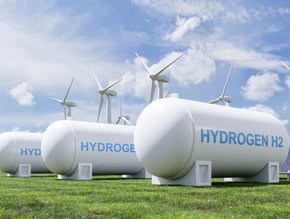Q&A with ESS’ Director of Europe Alan Greenshields

Around the world, there is great pressure on grid modernisation to ensure its resilience and to keep up with ever-increasing demand. But unprecedented delays are stopping these plans to secure grids’ futures in its tracks, potentially bringing up new problems when it comes to energy storage. In the UK, for example, the Enviromena battery project was slammed with a connection delay until 2036, a setback of 14 years.
This highlights the urgent need for grid modernisation and follows the news that the CEO of Octopus Energy is threatening to shift billions of pounds in energy investment overseas to avoid the UKs 200GW connection queue, and the 15 year wait for connecting renewable power projects to the grid.
Alan Greenshields, Director of Europe at ESS, is an expert in energy technology. He brings more than 20 years of experience in the rechargeable battery space. He started his career in high-volume manufacture of computer electronics with IBM and later worked as a senior manager in the Instrumentation Division of VDO Adolf Schindling, a world-leader in automotive instrumentation and now part of Continental.
Alan stresses the reason for the dire need for grid modernisation is because there has been no significant change to the grid for the last three decades, which is limiting renewable energy's mass deployment and threatening net-zero goals.
He believes the timelines to get these projects live could be significantly reduced with ample provision of Long Duration Energy Storage (LDES) to accelerate the transition to net-zero, improve energy security and lower consumer costs.
In this interview with Energy Digital, Alan will explore the root causes of these delays and discuss how LDES solutions can expedite the transition to renewable energy, and how ESS’ groundbreaking battery system is set to power Europe’s largest clean energy hub.
In your own words, what is ESS and what services does it provide?
ESS is accelerating global decarbonisation by manufacturing and deploying safe and sustainable LDES systems.
The company is backed by Bill Gates’ Breakthrough Energy Ventures, Honeywell International and SB Energy, and has developed iron flow batteries which deliver up to 12 hours of storage for commercial and industrial-scale projects. ESS iron flow technology uses safe, sustainable chemistry and simple earth-abundant materials – just iron, salt and water. ESS' iron flow technology leverages a broad and flexible supply chain, is largely reusable or recyclable at the end of life and has the lowest life cycle footprint of any competing storage technology according to the University of California - Irvine, supporting customers in achieving their sustainability commitments.
As well as sustainability benefits for customers, ESS technology offers cost-effective energy storage. This is especially true at scale when the benefits of a technology with an inherently low cost entitlement become increasingly apparent. Where Li-ion system costs increase roughly in proportion to storage capacity, iron-flow batteries rely upon a low-cost electrolyte made of iron, salt and water allowing the cost-effective addition of capacity. In addition, ESS’ iron flow chemistry overcomes challenges associated with Li-Ion batteries, such as toxic electrolytes, cooling requirements and fire risks.
Fundamentally, ESS’ iron flow batteries enable the clean energy transition. Our customers deploy iron flow technology to store excess renewable energy when available and use it when needed. It can support a wide range of applications — time-shifting renewable energy, ancillary grid services, smoothing the intermittency of renewables, supporting capacity needs and more. Due to the inherent safety of iron flow technology, there is no risk of thermal runaway, meaning iron flow batteries can safely operate in wildfire-prone and populated areas.
What factors do you believe are primarily responsible for the grid interconnection delays, and what potential solutions do you see to mitigate these delays?
The challenge primarily lies in an outdated grid and an outdated bureaucracy.
A predominantly renewable grid will look different than the fossil-based system upon which we have relied to date. While the UK’s National Grid has historically had 40 to 50 applications for connections a year, as we usher in the era of renewables, this number has risen to around 400 a year, representing ~234GW of renewable energy waiting to be connected to the grid.
Regulators have been criticised for grid interconnection delays potentially hindering this shift away from fossil fuels, with renewables groups sounding the alarm over UK grid connection delays of up to 13 years. The bureaucracy that manages grid interconnections needs reform to keep pace with the volume of requests. In the short term, transmission grid connections for power projects can be sped up by the UK enacting actions laid out in The Government and Ofgem's jointly published Connections Action Plan. This was released in November and includes key areas of action for the government, Ofgem, the Electricity System Operator (ESO) and network companies.
The plan raises entry requirements to improve the quality of projects applying for transmission connections. For example, the ESO will now require a landowner Letter of Authority to evidence permission from a landowner for a transmission network connection on their land. Both these steps are vital to ensure stalled or ‘zombie’ projects are ejected from the queue, and that capacity is made available for viable projects.
Fortunately, as energy experts continue to highlight the risks to decarbonisation targets, practical actions are being taken to decrease grid connection delays. For example, in November, the National Grid announced that it was accelerating the connection of up to 20GW of clean energy projects, meaning 19 battery energy storage projects worth around 10GW would be offered dates to plug in, averaging four years earlier than their current agreement. This was based on a new approach which removes the need for non-essential engineering works prior to connecting storage.
To limit grid interconnection delays, changes to help regulators slash red tape need to continue, with new policies implemented quickly and effectively.
How crucial is the provision of LDES in accelerating the transition to net-zero, and what role do you envision battery storage playing in addressing the challenges of grid connection delays?
As the world transitions to decarbonised energy systems, emerging LDES technologies will be critical for supporting the wide scale deployment of renewable energy sources. The LDES Council predicts that LDES need to be scaled up dramatically over the next 20 years to build a cost-optimal net-zero energy system, and that by 2040, LDES will need to have scaled up to ~400 times present day levels to 1.5 to 2.5TW (85 to 140TWh).
For all the energy that humans consume on this planet each year in homes, transport and industry, it takes just two minutes of the sun shining on the earth for the same energy to be replenished. But today, we are just not very good at harvesting and utilising this energy.
This is largely due to the inherent intermittency of renewable power generation and a grid designed to rely upon centralised, stationary fossil generation. To date, dispatchable fossil fuels — mostly natural gas — have enabled renewables by managing the variation in wind and solar generation to maintain grid stability. This no longer needs to be the case, as LDES systems can shift electricity from times of high supply to times of high demand, smoothing fluctuations in generation and providing increased flexibility, reliability and stability to the power system.
This is essential when addressing grid connection delays, as LDES can be used to ease transmission congestion by storing excess energy during periods of over-generation and deploying it when needed.
What strategies do you propose for incentivising investment in energy infrastructure while ensuring timely grid connections for renewable projects?
The House of Lords Science and Technology Committee recently released its report, ‘Long-duration energy storage: get on with it’, highlighting that the government must act fast to ensure LDES technologies can scale up and contribute to the decarbonisation of the electricity system.
It highlights that developers need a clear business case, supporting infrastructure — such as grid connections — and financial support in order to invest the substantial amount needed to scale up storage to tens of terawatt hours. Energy infrastructure projects can take years to build and the committee’s report outlined that a coordinated effort is needed to unlock the necessary up-front capital investment to build these projects and protect the UK from future energy supply shocks.
Similarly, the government has also recognised that additional financial support mechanisms are needed to enable investment in LDES. The Department for Energy Security & Net Zero set out some parameters of a proposed cap and floor scheme in a consultation in January.
A cap and floor subsidy works by setting an overall revenue cap and floor for a given facility in a contract between the storage facility and the government. If revenues exceed the cap, the extra is returned to the government. If revenues are less than the floor, the government pays the difference to the storage facility. The cap and floor mechanism limits risk by ensuring a minimum revenue, while incentivising the storage facility to operate to reach the revenue cap. This guarantee can drive private investment in necessary infrastructure without the expense of a blanket subsidy.
Contracts for difference, another policy intervention explored in the consultation, work in a similar way and involve agreeing a long-term contract with a ‘strike price’ for electricity usually set through a competitive auction. When the storage facility sells electricity into the wholesale market, the subsidy supplements the sale price to match the strike price — if the sale price exceeds the strike price, the storage owner pays the difference back. The revenue per MWh thereby becomes predictable.
What are the potential benefits and challenges associated with replacing coal-fired power stations with large-scale battery systems?
The transition from coal to clean is taking place worldwide. With existing transmission infrastructure and available land, existing coal power stations are providing ideal locations for future clean energy hubs. With around half of European power plants predicted to be retired by 2030, there is a huge opportunity for existing brownfield sites to be transformed into renewable energy hubs to support the clean energy transition.
This is not merely hypothetical. In eastern Germany, major electricity company Lausitz Energie Verwaltungs (LEAG) plans to transform its Boxberg power station into Europe’s largest-ever clean energy hub. ESS will be supplying a 50MW/500MWh battery system to the energy hub, which is expected to become a standardised building block in LEAG’s plan to ultimately deploy 7 to 14GW of renewable generation, 2 to 3 GWh of long-duration energy storage and up to 2GW of green hydrogen production.
We know that climate change is an urgent problem and that addressing it will require the deployment of clean energy capacity to continue to accelerate. As renewable and energy storage projects scale up, so too must the regulators and bureaucracies that enable them. With pioneering examples such as LEAG’s clean energy hub to light the way and policy frameworks such as CfD and cap and floor, regulators have clear examples to follow that will enable decarbonization while ensuring reliable, resilient energy systems.
*******************
Make sure you check out the latest edition of Energy Digital Magazine and also sign up to our global conference series - Sustainability LIVE 2024.
*******************
Energy Digital is a BizClik brand.






